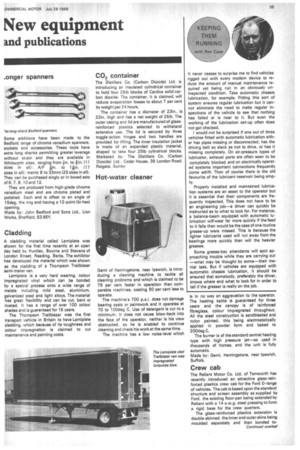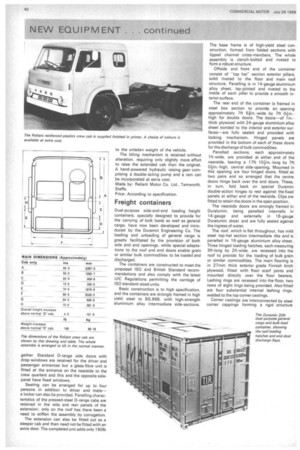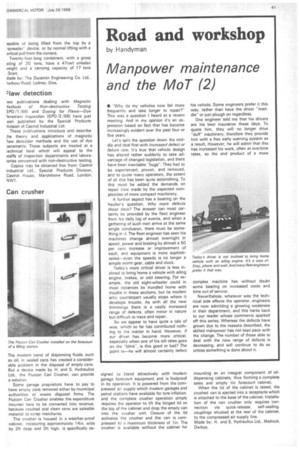New equipment
Page 41

Page 42

Page 43

If you've noticed an error in this article please click here to report it so we can fix it.
and publications
_onger spanners
Some additions have been made to the Bedford range of chrome vanadium spanners, sockets and accessories. These tools have extra long shanks permitting greater leverage without strain and they are available in Whitworth sizes, ranging from iin. to lin. (11 sizes in all); A/F in. to 14in. (17 sizes in all); metric 8 to 33mm125 sizes in all). They can be purchased singly or in boxed sets of 6, 7,8. 10 and 12.
They are produced from high-grade chrome vanadium steel and are chrome plated and polished. Each end is offset to an angle of 15deg, the ring end having a 12-point (bi-hex) opening.
Made by: John Bedford and Sons Ltd., Lion Works, Sheffield, S3 8EY.
-Cladding
A cladding material called Lamiplate was shown for the first time recently at an open day held by Huntley. Bourne and Stevens of London Street, Reading, Barks, The exhibitor has developed the material which was shown as the cladding of a Thompson Trailblazer semi-trailer van.
Lamiplate is a very hard wearing, colour impregnated vinyl which can be bonded by a special process onto a wide range of metals including mild steel, aluminium, galvanized steel and light alloys. The material has great flexibility and can be cut, bent or riveted. It has a range of over 100 colour shades and is guaranteed for 15 years.
The Thompson Trailblazer was the first transport vehicle in Britain to have Lamiplate cladding, which because of its toughness and colour impregnation is claimed to cut maintenance and painting costs.
CO2 container
The Distillers Co. (Carbon Dioxide) Ltd. is introducing an insulated cylindrical container to hold four 25Ib blocks of Cardice solid carbon dioxide. The container, it is claimed, will reduce evaporation losses to about 7 per cent by weight per 24 hours.
The container has a diameter of 23in., is 22in. high and has a net weight of 251b. The outer casing and lid are manufactured of glassreinforced plastics selected to withstand extensive use. The lid is secured by three toggle-action hinges and two handles are provided for lifting. The inner insulation jacket is made of an expanded plastic material, shaped to take four 25Ib cylindrical blocks. Marketed by: The Distillers Co. (Carbon Dioxide) Ltd.. Cedar House, 39 London Road, Reigate, Surrey.
Hot-water cleaner
Gerni of Hemingstone, near Ipswich, is introducing a cleaning machine to tackle all cleaning problems and which is claimed to be 75 per cent faster in operation than comparable machines, costing 50 per cent less to operate.
The machine's 700 psi. does not damage bearing seals or paintwork and it operates at 70 to 100deg C. Use of detergent is cut to a minimum. It does not cause blow-beck into the face of the operator, neither is his view obstructed, so he is enabled to continue cleaning and check his work at the same time.
The machine has a low noise-level which It never ceases to surprise me to find vehicles rigged out with every modern device to reduce the amount of manual maintenance required yet being run in an obviously uninspected condition. Take automatic chassis lubrication, for example. Fitting this sort of system ensures regular lubrication but it cannot eliminate the need to make regular inspections of the vehicle to see that nothing has failed or is near to it. But even the working of the lubrication set-up often does not get checked.
I would not be surprised if one out of three vehicles fitted with automatic lubrication either has pipes missing or disconnected, has the driving belt so slack as not to drive, or has it missing completely. On air-pressure types of lubricator, exhaust ports are often seen to be completely blocked and on electrically operated systems important connections frequently come adrift. Then of course there is the old favourite of the lubricant reservoir being empty.
Properly installed and maintained lubrication systems are an asset to the operator but it is essential that their components are frequently inspected. This does not have to be an engineering job—a driver can quickly be instructed as to what to look for. For instance, a balance-beam equipped with automatic lubrication will wear far more quickly if the feed to it fails than would be the case of one routine grease-up were missed. This is because the lighter lubricants used will run away from the bearings more quickly than will the heavier greases.
Some grease-bay attendants will spot approaching trouble while they are carrying out —what may be thought by some—their menial task. But if vehicles are equipped with automatic chassis lubrication, it should be ensured that somebody, preferably the driver, knows where and what to look for in order to tell if the greaser is really on the job.
is in no way an aggravation to the operator. The heating kettle is guaranteed for three years and the canopy is of reinforced fibreglass, colour impregnated throughout. All the steel construction is sandblasted and nylon painted, this being electrostatically applied in powder form and baked to 200deg C.
The burner is of the standard central heating type with high pressure jet—as used in thousands of homes, and the unit is fully automatic.
Made by: Gerni. Hemingstone, near Ipswich, Suffolk.
Crew cab
The Reliant Motor Co. Ltd. of Tamworth has recently introduced an attractive glass-reinforced plastics crew cab for the Ford D-range of vehicles. The cab is based upon the standard structure and screen assembly as supplied by Ford, the existing floor-pan being extended by Reliant with a 14 s.w.g. steel pressing to form a rigid base for the crew quarters.
The glass-reinforced plastics extension is double-skinned, the inner and outer skins being moulded separately and then bonded to gether. Standard D-range side doors with drop-windows are retained for the driver and passenger entrances but a glass-fibre unit is fitted at the entrance on the nearside to the crew quarters and this and the opposite sidepanel have fixed windows.
Seating can be arranged for up to four persons in addition to driver and mate--a locker can also be provided. Panelling characteristics of the pressed-steel 0-range cabs are retained in the side and rear panels of the extension; only on the roof has there been a need to stiffen the assembly by corrugation.
The extension can also be fitted out as a sleeper cab and then need not be fitted with an extra door. The completed unit adds only 190Ib to the unladen weight of the vehicle.
The tilting mechanism is retained without alteration, requiring only slightly more effort to raise the extended cab than the original. A hand-powered hydraulic raising gear comprising a double-acting pump and a ram can be incorporated at extra cost.
Made by: Reliant Motor Co. Ltd., Tamworth, Staffs.
Price: According to specification.
Freight containers
Dual-purpose side-and-end loading freight containers, specially designed to provide for the carrying of bulk loads as well as general cargo, have now been developed and introduced by the Duramin Engineering Co. The loading and unloading of general cargo is greatly facilitated by the provision of both side and end openings, while special adaptations to the roof and end doors enable grain or similar bulk commodities to be loaded and discharged.
The containers are constructed to meet the proposed ISO and British Standard recommendations and also comply with the latest UIC Regulations permitting the carriage of ISO standard-sized units.
Basic construction is to high specification, and the containers are strongly framed in high yield steel to BS.968, with high-strength aluminium alloy intermediate side-sections. The base frame is of high-yield steel construction, formed from folded sections with lipped channel cross-members. The whole assembly is clench-bolted and riveted to form a robust structure.
Offside and front end of the container consist of "top hat" section exterior pillars, solid riveted to the floor and main roof structure. Panelling is in 14-gauge aluminium alloy sheet, lap-jointed and riveted to the inside of each pillar to provide a smooth in terior surface.
The rear end of the container is framed in steel box section to provide an opening approximately 7ft 5i-in.-wide by 7ft high for double doors. The doors—of 1in.
thick plywood with 24-gauge aluminium alloy sheet bonded to the interior and exterior surfaces—are fully sealed and provided with locking mechanism. Hinged panels are provided in the bottom of each of these doors for the discharge of bulk commodities.
Panelled sections, each approximately 1ft-wide, are provided at either end of the nearside, leaving a 17ft 101.in.-long by 7ft 04-in. -high, central side-opening. Mounted in this opening are four hinged doors, fitted as two pairs and so arranged that the centre doors hinge back over the end doors. These, in turn, fold back on special Duramin double-action hinges to rest against the fixed panels at either end of the nearside. Clips are fitted to retain the doors in the open position.
The nearside doors are strongly framed in Duralumin, being panelled internally in 14-gauge and externally in 16-gauge Duralumin sheet and are fully sealed against the ingress of water.
The roof, which is flat throughout, has mild steel top-hat section intermediate ribs and is panelled in 16-gauge aluminium alloy sheet. Three hinged loading hatches, each measuring 3ft-long by 2ft-wide, are recessed into the roof to provide for the loading of bulk grain or similar commodities. The main flooring is in 27mm thick exterior grade Finnish birch plywood, fitted with floor scarf joints and mounted directly over the floor bearers. Lashing rings are recessed into the floor, two rows of eight rings being provided. Also fitted are four substantial internal lashing rings, welded to the top corner castings.
Corner castings are interconnected by steel corner cappings forming a rigid structure
apable of being lifted from the top by a 'spreader'' device, or by normal lifting with a ertical pull from the corners.
Twenty-foot-long containers, with a gross ating of 20 tons, have a 47cwt unladen veight and a carrying capacity of 17 tons 3cwt.
ilade by: The Duramin Engineering Co. Ltd., iarbour Road. Lydney, Glos.
:law detection
Wo publications dealing with Magnetic lethods of Non-destructive Testing SPD /68) and Dyeing for Flaws—Dye 'enetrant Inspection (SPD /2 /68) have just ,een published by the Special Products )ivision of Castro! Industrial Ltd.
These publications introduce and describe the theory and applications of magnetic law detection methods and the use of dye aenetrants. These subjects are treated at a technical level which will appeal to the staffs of inspection departments and laboratories concerned with non-destructive testing.
Copies may be obtained free from: Castrol Industrial Ltd., Special Products Division, Castro' House, Marylebone Road, London, NW1.
The modern trend of dispensing fluids, such as oil, in sealed cans has created a considerable problem in the disposal of empty cans. But a device made by H. and S. Hydraulics Ltd.. the Fluicon Can Crusher, can provide a solution.
Some garage proprietors have to pay to have empty cans removed either by municipal authorities or waste disposal firms. The Fluicon Can Crusher enables the expenditure incurred here to be converted into revenue, because crushed and clean cans are saleable material to scrap merchants.
The crusher is housed in a weather-proof cabinet, measuring approximately 14in. wide by 2ft deep and 3ft high, is specifically de
signed to blend attractively with modem garage forecourt equipment and is foolproof in its operation. It is powered from the compressed air supply which modern garages and petrol stations have available for tyre inflation. and the complete crusher operation simply requires the operator to lift the hinged lid on the top of the cabinet and drop the empty can into the crusher unit. Closure of the lid activates the crusher and the can is compressed to a maximum thickness of 1in. The crusher is available without the cabinet for mounting as an integral component of oil. dispensing cabinets, thus forming a complete sales and empty tin forecourt cabinet.
When the lid of the cabinet is raised, the crushed can is ejected into a receptacle which is attached to the base of the cabinet. Installation of the can crusher only requires connection via quick-release, self-sealing, couplings situated at the rear of the cabinet, to the compressed-air supply line.
Made by: H. and S. Hydraulics Ltd., Matlock, Derbys.












































































































